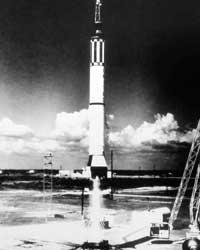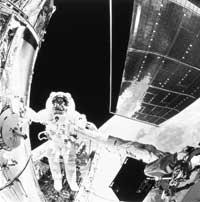From Earth to Moon

First, let us analyze if theoretically, at least, it is possible to throw a projectile with a cannon and not fall it to Earth. Theory tells us yes. Let's look at the two extreme possibilities. In the first of these, the shot will be made vertically upwards and with the Earth alone (neither air nor any other type of friction) it will be enough to equip the projectile with the kinetic energy necessary to get out of the influence of the Earth. In the event that the simple calculation gives the projectile a speed of 12,386 km/s (or higher), it can be observed that the said will occur.
Another option is to launch the projectile horizontally. Why in normal cases does the projectile fall to Earth? Because the earth pulls down. Therefore, his route is that of the line that leans towards the ground instead of being straight and finally meets him. It is true that the surface of the Earth is curved, but the inclination of the trajectory of the projectile is much more closed than that of the Earth. If we reduced the inclination of the trajectory of the projectile and made it as large as the surface of the Earth, the projectile would never fall to the Earth and continue to revolve around it, becoming the satellite of the Earth. But how can you get it? As before, giving the projectile the necessary speed.
In it we have the section of a sector of the terrestrial sphere. The canyon is located on top A of a mountain. If the Earth had no gravity, after a second horizontal shot, the projectile would be at point B. But the force of gravity changes this situation and, after a second, the projectile is located five meters below point B, that is, at point C (any body that freely falls on the Earth and in the void occupies a five-meter course in the first second). Therefore, if after lowering those five meters the projectile was at the same height of point A of the Earth's surface, its trajectory would be a concentric curve with the surface of the Earth's sphere.
Now we have to calculate the length of the AB segment, that is, the horizontal path that occupies the projectile in the first second, so the speed that the projectile must have when leaving the barrel mouth to achieve our goal. The calculation is simple: Taking the AOB triangle, it is straight at vertex A. On the other hand, considering OA = OC = radius of the terrestrial sphere, approximately 6.370.000 m, and OB = OC - BC = 6.370.005 m. We will have it through the theorem of Pythagoras, about 8,000 m.

That is, if it were not air (this puts a great obstacle to any body that goes at very high speed), any projectile launched horizontally and at an initial speed of 8 m/s would never fall on Earth.
And if the speed were higher, what would happen? According to kneading mechanics. The 8 km/s projectile to 11.2 km/s would cover the ellipses around the Earth and the ellipses will be longer as the initial speed increases. But with this speed of 11.2 km/s, instead of being ellipse, we will have an open curve, that is, a parable, that leaves the Earth forever.
Therefore, theoretically we can throw a cannon bullet to the Moon. For this you only have to give it a high initial speed.
Now we will analyze the trip to the Moon according to Julio Verne and reality. What happened after reading this novel. At that time something surprising happened: all the objects inside the projectile lost their weight, and the travelers themselves, who were suspended in the air without grabbing any wall. But the author did not take into account that the same thing had to happen before going through this point and also after, that is, that both passengers and objects would be ingravely from the very moment the journey began.
This seems a disfigurement, but after thinking a little, we will see that it has to be so. To realize this take another episode of the same novel by Julio Verne. As the reader will remember, the travelers saw that after throwing the dog's body out, instead of falling it to Earth, surprised, they continued in space along with the projector. Vern gives adequate response to this phenomenon with precision and accuracy. That is, as we know, as in the void the Earth gives the same acceleration to all bodies, all fall at the same speed. In this case, both the projectile and the dog's body, due to the influence of the Earth, would move exactly the same. Therefore, the relative speed between them will be zero, or what is the same, the body launched and the passengers would go together.
But what Verne did not take into account was: if the dog's body is outside the projectile and does not fall to Earth, why does it fall when it is inside? If the dog's body is placed inside the projectile (without any support, such as when it is outside), it hangs or stays in space, that is, the relative speed between both bodies is zero, so it stops from each other.

Without lips, everything we have said about the dog also happens with the bodies, with the passengers or with all the devices that are inside the projectile and therefore, even if the support points are lost, do not fall. That is, the chair located on the pavement inside the flying projectile, if it is placed upside down against the ceiling, will not fall down and continue against the ceiling. Any passenger can sit on it without fear of falling to the ground of the projectile (otherwise the chair would fall). But that is not possible, because we know that all things that are within the projectile have their own acceleration.
Jules Verne apparently did not realize that, in his opinion, inside the projectile, in free flight, the objects would press at their points of support, as they do when the projectile is standing. It is true that the bodies, when they are on a surface of the gravitational zone, press on it if the gaizanal is moving standing or at a uniform speed, but when a body and its support move in the space with the same acceleration, no pressure is made (if the accelerations are due to external forces, as is the case, and not to the influence of the projectile motor).
This means that, once the effect of the cannon gases on the projectile has been completed, travellers and other interior objects lost their weight and would remain without gravity. Knowing this, travelers could easily recognize it in the free space or inside the canyon. But the novelist did not realize this and in the first half of the sidereal trip tells us the headaches that travelers had to know if they flew or not:
- Nicholl, are we moving?
- Nicholl and Ardan looked. They did not feel the vibrations of the projectile.
- Or are we calm on the ground in Florida? Nicholl asked.
- Or at the bottom of the Gulf of Mexico, Michele added.
These conditions may be for ship passengers, but not for projectiles in free flight. The former will have their own weight, while the latter would lose their gravity and would be immediately to account.
The journey of this kind of projectile should be surprising! A small world in which bodies do not weigh and leave things free of hand and would remain in a quiet place without falling; objects would have their balance in any position and water would not fall when the bottle had to bend...
Unfortunately Julio Verne took into account all these things that he did not have in his work "From Earth to the Moon" and lost a great opportunity. However, the novel is really wonderful, despite having some physical error.





